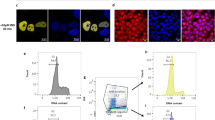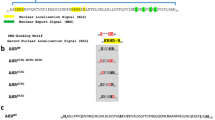Abstract
The aryl hydrocarbon receptor (AHR) is a ligand-dependent transcription factor involved in the metabolism of physiological substances and xenobiotics, representing an interesting target in both toxicology and pharmacology. In this study, we investigated the ligand-dependent conjunction of nuclear import of the human AHR in living cells and target gene induction. Our findings strengthen the theory that the AHR triggers a precisely defined and rapid reaction upon binding to endogenous ligands, while the xenobiotic β-naphthoflavone only induces rather unspecific and slow effects. To better illuminate the ligand-mediated responses of the human AHR, we applied site-directed mutagenesis and identified histidine 291 as key residue for AHR functionality, essential for both nuclear import and target gene induction. Contrary, replacing histidine at position 291 by alanine did not affect nucleo-cytoplasmic shuttling, showing that permanent endogenous import and ligand-induced import of the AHR into the nucleus are two independent and differently regulated processes. Combining these observations with our structural investigations using a homology model of the AHR-PAS B domain, we suggest a dual role of histidine 291: (1) a major role for shaping the ligand binding site including direct interactions with ligands and, (2) an essential role for the conformational dynamics of a PAS B loop, which most likely influences the association of the AHR with the AHR nuclear translocator through interference with their protein–protein interface.





Similar content being viewed by others
References
Adachi J et al (2001) Indirubin and indigo are potent aryl hydrocarbon receptor ligands present in human urine. J Biol Chem 276:31475–31478. https://doi.org/10.1074/jbc.C100238200
Barouki R, Aggerbeck M, Aggerbeck L, Coumoul X (2012) The aryl hydrocarbon receptor system. Drug Metabol Drug Interact 27:3–8. https://doi.org/10.1515/dmdi-2011-0035
Beischlag TV, Luis Morales J, Hollingshead BD, Perdew GH (2008) The aryl hydrocarbon receptor complex and the control of gene expression. Crit Rev Eukaryot Gene Expr 18:207–250
Bergander L, Wincent E, Rannug A, Foroozesh M, Alworth W, Rannug U (2004) Metabolic fate of the Ah receptor ligand 6-formylindolo[3,2-b]carbazole. Chem Biol Interact 149:151–164. https://doi.org/10.1016/j.cbi.2004.08.005
Bermudez M, Mortier J, Rakers C, Sydow D, Wolber G (2016) More than a look into a crystal ball: protein structure elucidation guided by molecular dynamics simulations. Drug Discov Today 21:1799–1805. https://doi.org/10.1016/j.drudis.2016.07.001
Bessede A et al (2014) Aryl hydrocarbon receptor control of a disease tolerance defence pathway. Nature 511:184–190. https://doi.org/10.1038/nature13323
Bisson WH et al (2009) Modeling of the aryl hydrocarbon receptor (AhR) ligand binding domain and its utility in virtual ligand screening to predict new AhR ligands. J Med Chem 52:5635–5641. https://doi.org/10.1021/jm900199u
Bowers KJ et al (2006) Scalable algorithms for molecular dynamics simulations on commodity clusters. In: SC 2006 conference, proceedings of the ACM/IEEE, 11–17 Nov. 2006, pp 43–43. https://doi.org/10.1109/SC.2006.54
Chen G, Bunce NJ (2004) Interaction between halogenated aromatic compounds in the Ah receptor signal transduction pathway. Environ Toxicol 19:480–489. https://doi.org/10.1002/tox.20053
Chen PH, Chang JT, Li LA, Tsai HT, Shen MY, Lin P (2013) Aryl hydrocarbon receptor is a target of 17-Allylamino-17-demethoxygeldanamycin and enhances its anticancer activity in lung adenocarcinoma cells. Mol Pharmacol 83:605–612. https://doi.org/10.1124/mol.112.081646
Connor KT, Aylward LL (2006) Human response to dioxin: aryl hydrocarbon receptor (AhR) molecular structure, function, and dose-response data for enzyme induction indicate an impaired human AhR. J Toxicol Environ Health B Crit Rev 9:147–171. https://doi.org/10.1080/15287390500196487
De Abrew KN, Phadnis AS, Crawford RB, Kaminski NE, Thomas RS (2011) Regulation of Bach2 by the aryl hydrocarbon receptor as a mechanism for suppression of B-cell differentiation by 2,3,7,8-tetrachlorodibenzo-p-dioxin. Toxicol Appl Pharmacol 252:150–158. https://doi.org/10.1016/j.taap.2011.01.020
Esser C, Rannug A (2015) The aryl hydrocarbon receptor in barrier organ physiology, immunology, and toxicology. Pharmacol Rev 67:259–279. https://doi.org/10.1124/pr.114.009001
Fritsche E et al (2007) Lightening up the UV response by identification of the arylhydrocarbon receptor as a cytoplasmatic target for ultraviolet B radiation. Proc Natl Acad Sci USA 104:8851–8856. https://doi.org/10.1073/pnas.0701764104
Goryo K et al (2007) Identification of amino acid residues in the Ah receptor involved in ligand binding. Biochem Biophys Res Commun 354:396–402. https://doi.org/10.1016/j.bbrc.2006.12.227
Henkler F, Stolpmann K, Luch A (2012) Exposure to polycyclic aromatic hydrocarbons: bulky DNA adducts and cellular responses. EXS 101:107–131. https://doi.org/10.1007/978-3-7643-8340-4_5
Humphrey W, Dalke A, Schulten K (1996) VMD: visual molecular dynamics. J Mol Graph 14:33–38 (27–38)
Jones PB, Galeazzi DR, Fisher JM, Whitlock JP Jr (1985) Control of cytochrome P1-450 gene expression by dioxin. Science 227:1499–1502
Jones G, Willett P, Glen RC, Leach AR, Taylor R (1997) Development and validation of a genetic algorithm for flexible docking. J Mol Biol 267:727–748. https://doi.org/10.1006/jmbi.1996.0897
Josefowicz SZ, Lu LF, Rudensky AY (2012) Regulatory T cells: mechanisms of differentiation and function. Annu Rev Immunol 30:531–564. https://doi.org/10.1146/annurev.immunol.25.022106.141623
Key J, Scheuermann TH, Anderson PC, Daggett V, Gardner KH (2009) Principles of ligand binding within a completely buried cavity in HIF2alpha PAS-B. J Am Chem Soc 131:17647–17654. https://doi.org/10.1021/ja9073062
Luch A (2005) Nature and nurture—lessons from chemical carcinogenesis. Nat Rev Cancer 5:113–125. https://doi.org/10.1038/nrc1546
McGuire J, Okamoto K, Whitelaw ML, Tanaka H, Poellinger L (2001) Definition of a dioxin receptor mutant that is a constitutive activator of transcription: delineation of overlapping repression and ligand binding functions within the PAS domain. J Biol Chem 276:41841–41849. https://doi.org/10.1074/jbc.M105607200
Mortier J, Rakers C, Bermudez M, Murgueitio MS, Riniker S, Wolber G (2015) The impact of molecular dynamics on drug design: applications for the characterization of ligand-macromolecule complexes. Drug Discov Today 20:686–702. https://doi.org/10.1016/j.drudis.2015.01.003
Murray IA, Patterson AD, Perdew GH (2014) Aryl hydrocarbon receptor ligands in cancer: friend and foe. Nat Rev Cancer 14:801–814. https://doi.org/10.1038/nrc3846
Ohtake F et al (2003) Modulation of oestrogen receptor signalling by association with the activated dioxin receptor. Nature 423:545–550. https://doi.org/10.1038/nature01606
Opitz CA et al (2011) An endogenous tumour-promoting ligand of the human aryl hydrocarbon receptor. Nature 478:197–203. https://doi.org/10.1038/nature10491
Pandini A, Denison MS, Song Y, Soshilov AA, Bonati L (2007) Structural and functional characterization of the aryl hydrocarbon receptor ligand binding domain by homology modeling and mutational analysis. Biochemistry 46:696–708. https://doi.org/10.1021/bi061460t
Parks AJ et al (2014) In silico identification of an aryl hydrocarbon receptor antagonist with biological activity in vitro and in vivo. Mol Pharmacol 86:593–608. https://doi.org/10.1124/mol.114.093369
Perkins A, Phillips JL, Kerkvliet NI, Tanguay RL, Perdew GH, Kolluri SK, Bisson WH (2014) A structural switch between agonist and antagonist bound conformations for a ligand-optimized model of the human aryl hydrocarbon receptor ligand binding domain. Biology (Basel) 3:645–669. https://doi.org/10.3390/biology3040645
Powell JB, Goode GD, Eltom SE (2013) The aryl hydrocarbon receptor: a target for breast cancer therapy. J Cancer Ther 4:1177–1186. https://doi.org/10.4236/jct.2013.47137
Probst MR, Reisz-Porszasz S, Agbunag RV, Ong MS, Hankinson O (1993) Role of the aryl hydrocarbon receptor nuclear translocator protein in aryl hydrocarbon (dioxin) receptor action. Mol Pharmacol 44:511–518
Rakers C, Bermudez M, Keller BG, Mortier J, Wolber G (2015) Computational close up on protein–protein interactions: how to unravel the invisible using molecular dynamics simulations? Wiley interdisciplinary reviews. Comput Mol Sci 5:345–359. https://doi.org/10.1002/wcms.1222
Seok SH et al (2017) Structural hierarchy controlling dimerization and target DNA recognition in the AHR transcriptional complex. Proc Natl Acad Sci USA 114:5431–5436. https://doi.org/10.1073/pnas.1617035114
Soshilov AA, Denison MS (2014) Ligand promiscuity of aryl hydrocarbon receptor agonists and antagonists revealed by site-directed mutagenesis. Mol Cell Biol 34:1707–1719. https://doi.org/10.1128/mcb.01183-13
Stockinger B, Di Meglio P, Gialitakis M, Duarte JH (2014) The aryl hydrocarbon receptor: multitasking in the immune system. Ann Rev Immunol 32:403–432. https://doi.org/10.1146/annurev-immunol-032713-120245
Tkachenko A et al (2016) The Q-rich/PST domain of the AHR regulates both ligand-induced nuclear transport and nucleocytoplasmic shuttling. Sci Rep 6:32009. https://doi.org/10.1038/srep32009
van den Bogaard EH et al (2015) Genetic and pharmacological analysis identifies a physiological role for the AHR in epidermal differentiation. J Invest Dermatol 135:1320–1328. https://doi.org/10.1038/jid.2015.6
Wincent E et al (2009) The suggested physiologic aryl hydrocarbon receptor activator and cytochrome P4501 substrate 6-formylindolo[3,2-b]carbazole is present in humans. J Biol Chem 284:2690–2696. https://doi.org/10.1074/jbc.M808321200
Wolber G, Seidel T, Bendix F, Langer T (2008) Molecule-pharmacophore superpositioning and pattern matching in computational drug design. Drug Discov Today 13:23–29. https://doi.org/10.1016/j.drudis.2007.09.007
Xing Y et al (2012) Identification of the Ah-receptor structural determinants for ligand preferences. Toxicol Sci 129:86–97. https://doi.org/10.1093/toxsci/kfs194
Acknowledgements
We thank the computing center of the Freie Universität Berlin (ZEDAT) for providing the compute cluster SOROBAN for molecular dynamics calculations.
Author information
Authors and Affiliations
Corresponding author
Ethics declarations
Funding sources
We acknowledge intramural funding at the German Federal Institute for Risk Assessment (BfR) Grant #1322-338.
Electronic supplementary material
Below is the link to the electronic supplementary material.
Rights and permissions
About this article
Cite this article
Tkachenko, A., Bermudez, M., Irmer-Stooff, S. et al. Nuclear transport of the human aryl hydrocarbon receptor and subsequent gene induction relies on its residue histidine 291. Arch Toxicol 92, 1151–1160 (2018). https://doi.org/10.1007/s00204-017-2129-0
Received:
Accepted:
Published:
Issue Date:
DOI: https://doi.org/10.1007/s00204-017-2129-0




